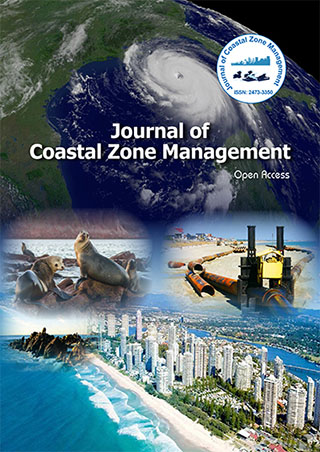Indexed In
- SafetyLit
- RefSeek
- Hamdard University
- EBSCO A-Z
- OCLC- WorldCat
- Publons
Useful Links
Share This Page
Journal Flyer

Open Access Journals
- Agri and Aquaculture
- Biochemistry
- Bioinformatics & Systems Biology
- Business & Management
- Chemistry
- Clinical Sciences
- Engineering
- Food & Nutrition
- General Science
- Genetics & Molecular Biology
- Immunology & Microbiology
- Medical Sciences
- Neuroscience & Psychology
- Nursing & Health Care
- Pharmaceutical Sciences
Opinion Article - (2024) Volume 27, Issue 6
Impacts of Climate Change on Coastal Wetlands: Mangrove Degradation and Restoration Strategies
Ivan Rioz*Received: 28-Oct-2024, Manuscript No. JCZM-24-27582; Editor assigned: 30-Oct-2024, Pre QC No. JCZM-24-27582 (PQ); Reviewed: 15-Nov-2024, QC No. JCZM-24-27582; Revised: 22-Nov-2024, Manuscript No. JCZM-24-27582 (R); Published: 29-Nov-2024, DOI: 10.35248/2473-3350.24.27.654
Description
Coastal wetlands, including mangroves, salt marshes and estuaries, serve as major ecosystems that protect shorelines from storm surges, reduce erosion, store carbon and provide habitat for diverse species. Mangroves, in particular, are regarded as the "guardians" of the coast, offering protection against waves and floods while simultaneously supporting fisheries and biodiversity. Unfortunately, the threats posed by climate change-rising sea levels, increased storm intensity and changing weather patterns are accelerating the degradation of these ecosystems. This has extreme consequences for both the environment and coastal communities that rely on them for their livelihoods.
The role of mangroves in coastal protection
Mangrove forests are uniquely adapted to thrive in the saline, waterlogged environments of coastal zones. Their complex root systems not only anchor soil and reduce erosion but also trap sediment, helping to stabilize coastlines. Beyond their physical protective capabilities, mangroves also lead a critical role in carbon sequestration, with studies showing that they store more carbon per unit area than terrestrial forests.
Sea-level rise is one of the most extreme challenges for mangroves. As coastal waters encroach further inland, higher salinity levels and waterlogged conditions can hinder mangrove growth and regeneration. In addition, the increased frequency and intensity of storms associated with climate change can cause significant physical damage to mangrove forests. Strong winds, waves and storm surges can uproot trees and erode the soil, further weakening the coastline’s natural defenses.
In Southeast Asia, which is home to a large portion of the world's mangroves, the impact of these changes is already evident. Countries like Indonesia and the Philippines are losing their mangroves at an alarming rate due to a combination of sea-level rise, unsustainable land-use practices and illegal logging. Indonesia alone has lost more than 40% of its mangrove forests in recent decades, threatening not only the environment but also the livelihoods of millions who depend on these ecosystems for fishing and protection from natural disasters.
While the degradation of mangroves is a serious concern, there are successful efforts underway to restore these ecosystems. Restoration strategies involve planting new mangrove trees, rehabilitating degraded areas and protecting existing forests from further damage. In the Philippines, for example, community-led mangrove reforestation projects have proven effective in regenerating damaged coastal areas. These efforts not only improve coastal resilience to storms and flooding but also restore important habitats for marine species.
Indonesia has also embarked on large-scale mangrove restoration initiatives, including a government-led project aimed at rehabilitating 600,000 hectares of mangroves by 2024. These efforts are essential for preserving biodiversity, enhancing coastal protection and combating climate change through carbon sequestration.
Another challenge lies in addressing the root causes of mangrove loss, including coastal development, deforestation and pollution. Policymakers must work together with local communities and scientists to develop sustainable land-use practices and protect remaining mangrove forests from further degradation.
Mangroves are among the most valuable ecosystems on Earth, providing critical services such as coastal protection, carbon storage and habitat support. However, climate change is pushing these ecosystems to the brink, particularly in regions like Southeast Asia where rising sea levels and storm intensity are most severe. Restoration efforts, though prominent and require careful planning, long-term commitment and cooperation among interested groups. Through these efforts, it is possible to mitigate the effects of climate change on coastal wetlands and ensure their survival for perspective generations.
Citation: Rioz I (2024). Impacts of Climate Change on Coastal Wetlands: Mangrove Degradation and Restoration Strategies. J Coast Zone Manag. 27:654.
Copyright: © 2024 Rioz I. This is an open-access article distributed under the terms of the Creative Commons Attribution License, which permits unrestricted use, distribution, and reproduction in any medium, provided the original author and source are credited.
